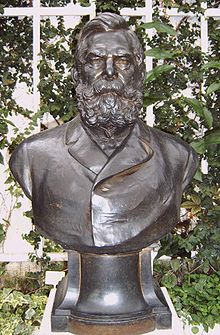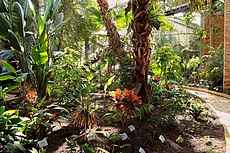Gruson greenhouses
The Gruson greenhouses are a botanical garden in Magdeburg and contain an important collection of plants dating back to the 19th century. Today you belong to the Network Garden Dreams Saxony-Anhalt .
investment
In the ten show houses of the greenhouse complex, approx. 4500 plant species (as of February 2018) in over 6000 origins are kept under a covered area of 4000 m². The plant operated by the city of Magdeburg houses plants from five continents. The Klosterbergegarten is directly adjacent to the complex .
Showhouses
The 16 meter high palm house is the location for approx. 50 types of palm , tree strelitzia and also for the giant bamboo . A treetop path in the house allows visitors to climb up to the height of the treetops.
The fern house presents itself with ferns , some of which are over 130 years old . In addition to tree and cycads, there are maidenhair , fringe , antler and sword ferns as well as very large specimens of the genera Cibotium and Angiopteris .
In the Mediterranean house , plants from the Mediterranean and the Canary Islands are shown. In the Canary Islands you can see many species of adder heads , Canary daisies and Canary houseleek as well as other representatives of the endemic Canary Islands flora. Typical representatives of the Mediterranean area are laurel , dwarf palm and olive trees . In addition, there are other typical and sometimes very rare representatives of this popular holiday destination. It is rounded off by plants from the nurseries, which are cultivated in pots and exhibited there during flowering, including one of the largest collections of Mediterranean bulbous and tuberous plants in Germany.
The little Queen of the Night house shows some representatives of this night flowering genus, supplemented by species of coral cacti and porcelain flowers .
This is followed by the Great Tropical House , which houses plants from the tropics of the Old World . A large number of Ficus species, ginger and arum plants can be seen there. Several species of Sansevieria are exhibited in a dry area . In addition, as representatives of important tropical crops, a regularly blooming banana tree , a large coffee bush , mango , pepper and oil palm grow there . This tropical house is also the home of two female brow-browed caimans who share their basin with turtles and various cichlids . In an aviary you can spot chameleons and day geckos . Connected to the large tropical house is the aquarium area with seven freshwater and one seawater basins as well as two terrariums, one for dye frogs and one with sky-blue day geckos .
In the small tropical house you can see plants from the tropics of the American double continent, including heliconias and various acanthus plants . Attached is the Viktoriahaus , which is home to the giant water lily Victoria cruziana as the biggest attraction in summer . Mimosa , passion flowers , rice , sugar cane and a giant pipe flower ( Aristolochia gigantea ) also grow in this show house . A group of ostrich quail is on the move in both tropical houses .
In the orchid house you will find orchids, part of the large (over 400 species) bromeliad collection and, each in an air-conditioned display case, carnivorous plants and miniature orchids. Three regularly blooming types of vanilla climb around in the gable area.
The winter garden is once winter quarters for some larger tub plants such as angel's trumpets , ironwood trees and bird of paradise , but also a planting area for various hibiscus and other cold house plants, including larger cycads of the genera Encephalartos and Cycas .
This is followed by the bromeliad house . Here the range of the orchid house is supplemented by pineapple plants from the arid regions, such as Puya , Dyckia and Hechtia .
Last but not least, you come to the cactus house with its several hundred species of cacti - and other succulents . Among them is a group of Echinocactus grusonii , the “mother-in-law chair”, with a specimen that is around 150 years old.
A generous exchange of substrates has been carried out since 2013 and some of the show houses (palm house, Mediterranean house, large and small tropical house) have been completely redesigned and planted. The fern, orchid, bromeliad and cactus house and the winter garden are to follow in the next few years.
April 2020 began with the construction of the fern and cactus house and the winter garden. This had become necessary for security reasons. The reopening is scheduled for mid-March 2021.
Male ostrich quail ( Rollulus rouloul )
Gold ball cactus ( Echinocactus grusonii ) in the cactus house
history

After the death of the Magdeburg industrialist and plant collector Hermann Gruson , his family donated the extensive plant collection he had compiled to the city of Magdeburg in 1895. In addition, the son Hermann and Gruson's wife Helene donated 100,000 marks to make the acceptance easier for the city. The donation to the city also had a pragmatic reason. The entrepreneur probably did not intend to keep his residence on the factory premises in Buckau. After the factory had already been taken over by Friedrich Krupp AG in 1893 , he wanted to have the preservation of his private property clarified, as he had lifelong right to live on the site. The Gruson family therefore attached five conditions to taking over the plant collection:
- Only the city should undertake to maintain the collection.
- The maintenance of the plants should be done in the sense of Gruson.
- The collection was to be named Grusons “forever”.
- The plants should be made available to everyone, if necessary, with free days for the exhibition.
- The city had to take over Gruson's gardeners and apprentices in training.
The large public greenhouse complex at the Klosterbergegarten was built in 1896 for the collection that had been housed in Freie Strasse . With the help of his head gardener Albert Mathsson, Gruson had gathered what was probably the largest collection of cacti and succulents in Europe at the time. In 1889 Mathsson had even set out on a collective expedition to Mexico on behalf of Gruson . Gruson had also had many copies sent to him through his friend Karwinsky, who lived in Mexico. He received several honors for this during his lifetime. The German Cactus Society held its general meeting in his greenhouses in 1894 in his honor. Four types of cactus got his name, including the mother-in-law chair or gold ball cactus . In addition, Gruson regularly invited guests, visitors, interested parties and business friends to his garden and greenhouses. He spent around 20,000 marks a year on watering and caring for the cacti and succulents alone.
On April 12, 1896, the facility opened under the name Gruson greenhouse and palm houses of the city of Magdeburg . The exhibition was well attended from the start and the houses were popular event destinations for clubs and day trips for school groups. Up until the 1920s, one day a week was free of charge. Several Magdeburg citizens donated valuable plants to the houses. A bust of Gruson is still in the house today.
The administration building with the adjacent greenhouse, the Mediterranean house and the cactus house used today as a classroom have been preserved from the founding time. The classroom partly consists of components, which in the chill casting were, a process developed by Hermann Gruson method was prepared.
In 1910, the Viktoriahaus, which has also been preserved, was built as a concrete-encased steel structure.
During the Second World War , an air raid on Magdeburg in September 1944 caused severe damage to the facility. Virtually all of the glass was broken. The palm house was destroyed. The valuable plant population had also suffered losses.
After the war ended, some war damage was quickly repaired. As early as the summer of 1945, the cactus house (today botany school), the succulent house (today Mediterranean house) and the large tropical house were reopened. The other houses followed. However, the large palm house was only reopened in 1986 after more than 40 years. The original representative entrance was only rebuilt in 2010. The temporary entrance to the administration building was replaced after 65 years. In 1975 a botany school was opened. Interested groups and especially school classes are trained in botany in the training room.
In the first 100 years, the Gruson greenhouses visited about six million gardeners.
literature
- Maren Ballerstedt u. a .: 100 years of Gruson - greenhouses Magdeburg - exotic plant collection - 1896 - 1996 . Magdeburg 1996.
- Johann August Duvigneau: Magdeburg 1825 - 1925 , in: Hans Leonhard (Ed.), Memorandum for the centenary of the Magdeburg Chamber of Commerce and Industry , Magdeburg 1925, pp. 87-138.
- Ernst Gruson: From the days of our ancestors - and from our time. History of the Gruson family . Quedlinburg 1924.
- Volker Mothes: Hermann Gruson. Entrepreneur and scientist from Magdeburg . In: Treatises and reports for natural history , Vol. 28 (2005), ISSN 0945-7658 , pp. 53-70.
Movie
- Where steel was hardened - the mechanical engineering city of Magdeburg. Documentary, Germany, 2019, 44:44 min., Script and director: Tom Kühne, production: MDR , series: Der Osten - Discover where you live , first broadcast: January 14, 2020 on MDR television , synopsis from MDR, online video Accessible until January 6, 2021. Visiting the Gruson greenhouses from 7:57 - 11:36 min.
See also
Web links
Coordinates: 52 ° 6 ′ 49.8 " N , 11 ° 37 ′ 53.8" E






